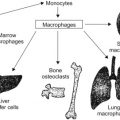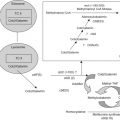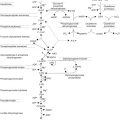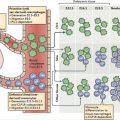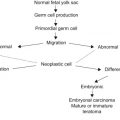Abstract
Childhood non-Hodgkin lymphoma (NHL) is distinguished from adult NHL by differing frequencies of histopathologic types and by the greater frequency of extranodal presentations. With current combination chemotherapy regimens, survival is generally excellent (85 to over 90%) for all patients, including those with disseminated disease, bone marrow involvement, central nervous system involvement, and high serum lactate dehydrogenase.
Keywords
Burkitt lymphoma, anaplastic large-cell lymphoma, LMB-96, lymphoid neoplasms, lymphoblastic lymphoma, large B cell lymphoma
Introduction
Childhood non-Hodgkin lymphoma (NHL) is distinguished from adult NHL by differing frequencies of histopathologic types and by the greater frequency of extranodal presentations. With current combination chemotherapy regimens, survival is generally excellent (85 to over 90%) for all patients, including those with disseminated disease, bone marrow involvement, central nervous system (CNS) involvement, and high serum lactate dehydrogenase (LDH).
With improved survival in all subtypes and stages, recent efforts have focused on maintaining excellent event-free survival (EFS) with reduced late toxicity by incorporating more specific targeted therapies for patients with less favorable subgroups of NHL and identifying new prognostic factors.
Incidence and Epidemiology
Incidence
- 1.
NHL represents approximately 6–8% of all malignancies in patients under 20 years of age.
- 2.
Surveillance, Epidemiology and End Results data estimate an incidence of about 1 per 100,000, with an annual incidence of 750–800 cases per year in children up to 19 years of age in the United States.
- 3.
There is geographic variation in the incidence of NHL. For example, in equatorial Africa, Burkitt lymphoma (BL) accounts for almost 50% of all childhood cancers. In this setting, endemic BL is invariably positive for Epstein–Barr virus (EBV), in contrast to about 10% of cases of sporadic BL.
- 4.
There has been a gradual increase in incidence of NHL in the United States over the past 40 years, more pronounced in the 15–19 age group.
Epidemiology
- •
Sex : Male:female is 2–3:1.
- •
Age : Median age of presentation is 10 years. It is rare to have cases under 3 years of age.
- •
Risk factors : Inherited or acquired risk factors have been identified, including those listed below. NHL may develop as second malignancy after chemotherapy and/or radiation therapy or in the setting of congenital or acquired immunodeficiency.
- •
Genetics : Immunological defects (Bruton type of sex-linked agammaglobulinemia, common variable agammaglobulinemia, severe combined immunodeficiency ataxia-telangiectasia, Bloom syndrome, Wiskott–Aldrich syndrome, autoimmune lymphoproliferative syndrome).
- •
Post-transplant immunosuppression : Post bone marrow transplantation (especially with use of T-cell-depleted marrow), post-solid organ transplantation.
- •
Lymphomatoid papulosis in children may evolve into or coexist with anaplastic large-cell lymphoma (ALCL).
- •
- •
Drugs : Infliximab and other immunosuppressive agents used in inflammatory bowel disease and autoimmune disease.
- •
Viral : EBV, human immune deficiency virus (HIV) and possible link to human T-lymphotropic virus.
Pathologic Classification
Table 22.1 presents the World Health Organization (WHO) classification for lymphoid neoplasms from the International Lymphoma Study Group and incorporates histology as well as immunohistochemistry, gene expression profiling, cytogenetic, molecular and clinical features.
| PRECURSOR LYMPHOID NEOPLASMS |
| B lymphoblastic leukemia/lymphoma NOS |
| B lymphoblastic leukemia/lymphoma with recurrent genetic abnormalities |
| B lymphoblastic leukemia/lymphoma with t(9;22); bcr-abl1 |
| B lymphoblastic leukemia/lymphoma with t(v;11q23); MLL rearranged |
| B lymphoblastic leukemia/lymphoma with t(12:21); TEL-AML1 and ETV6-RUNX1 |
| B lymphoblastic leukemia/lymphoma with hyperploidy |
| B lymphoblastic leukemia/lymphoma with hypodiploidy |
| B lymphoblastic leukemia/lymphoma with t(5;14); IL3-IGH |
| B lymphoblastic leukemia/lymphoma with t(1;19); E2A-PBX1 and TCF3-PBX1 |
| T lymphoblastic leukemia/lymphoma |
| MATURE B-CELL NEOPLASMS |
| Chronic lymphocytic leukemia/small lymphocytic lymphoma |
| B-cell prolymphocytic leukemia |
| Splenic marginal zone lymphoma |
| Hairy cell leukemia |
| Lymphoplasmacytic lymphoma/Waldenstrom macroglobulinemia |
| Heavy chain disease |
| Plasma cell myeloma |
| Solitary plasmacytoma of bone |
| Extraosseous plasmacytoma |
| Extranodal marginal zone B-cell lymphoma of mucosa-associated lymphoid tissue type |
| Nodal marginal zone lymphoma |
| Follicular lymphoma |
| Primary cutaneous follicular lymphoma |
| Mantle cell lymphoma |
| Diffuse large B-cell lymphoma, NOS (T-cell/histiocyte-rich type; primary CNS type; primary leg skin type and EBV+ elderly type) |
| Diffuse large B-cell lymphoma with chronic inflammation |
| Lymphomatoid granulomatosis |
| Primary mediastinal large B-cell lymphoma |
| Intravascular large B-cell lymphoma |
| ALK+ large B-cell lymphoma |
| Plasmablastic lymphoma |
| Large B-cell lymphoma associated with human herpes virus 8+Castleman disease |
| Primary effusion lymphoma |
| Burkitt lymphoma |
| B-cell lymphoma, unclassifiable, Burkitt-like |
| B-cell lymphoma, unclassifiable, Hodgkin lymphoma-like |
| MATURE T-CELL AND NK-CELL NEOPLASMS |
| T-cell prolymphocytic leukemia |
| T-cell large granular lymphocytic leukemia |
| Chronic lymphoproliferative disorder of NK cells |
| Aggressive NK-cell leukemia |
| Systemic EBV+ T-cell lymphoproliferative disorder of childhood |
| Hydroa vacciniforme-like lymphoma |
| Adult T-cell lymphoma/leukemia |
| Extranodal T-cell/NK-cell lymphoma, nasal type |
| Enteropathy-associated T-cell lymphoma |
| Hepatosplenic T-cell lymphoma |
| Subcutaneous panniculitis-like T-cell lymphoma |
| Mycosis fungoides |
| Sézary syndrome |
| Primary cutaneous CD30+ T-cell lymphoproliferative disorder |
| Primary cutaneous gamma-delta T-cell lymphoma |
| Peripheral T-cell lymphoma, NOS |
| Angioimmunoblastic T-cell lymphoma |
| Anaplastic large cell lymphoma, ALK+ type |
| Anaplastic large cell lymphoma, ALK− type |
| HODGKIN LYMPHOMA (HODGKIN DISEASE) |
| Nodular lymphocyte-predominant Hodgkin lymphoma |
| Classic Hodgkin lymphoma |
| Nodular sclerosis Hodgkin lymphoma |
| Lymphocyte-rich classic Hodgkin lymphoma |
| Mixed cellularity Hodgkin lymphoma |
| Lymphocyte depletion Hodgkin lymphoma |
| PTLD |
| Plasmacytic hyperplasia |
| Infectious mononucleosis like PTLD |
| Polymorphic PTLD |
| Monomorphic PTLD (B and T/NK cell types) |
| Classic HD type PTLD |
| HISTIOCYTIC AND DENDRITIC CELL NEOPLASMS |
| Histiocytic sarcoma |
| Langerhans cell histiocytosis |
| Langerhans cell sarcoma |
| Interdigitating dendritic cell sarcoma |
| Follicular dendritic cell sarcoma |
| Fibroblastic reticular cell tumor |
| Indeterminate dendritic cell sarcoma |
| Disseminated juvenile xanthogranuloma |
Pediatric NHL is mostly (more than 95%) high-grade and includes the following four major subtypes:
- 1.
B- and T-lymphoblastic lymphoma (LL).
- 2.
BL.
- 3.
Diffuse large B-cell lymphoma (DLBCL).
- 4.
ALCL.
Many of these high-grade lymphomas disseminate noncontiguously, evolve into a leukemic phase, and involve the CNS. The more common low-grade lymphomas seen in adults, such as follicular and marginal zone, are rare in children. T and B-LL comprise about 20% of NHL in childhood; T-cell is the more common type. Mature B-cell lymphoma includes both BL (19% of cases) as well as DLBCL and primary mediastinal large B-cell lymphoma (PMBL). Together the latter two comprise approximately 22% of NHL in childhood. In the current WHO classification, PMBL is considered distinct from other DLBCL based upon its unique clinical, histologic, and molecular features. Other mature B-cell lymphomas, including pediatric marginal zone lymphoma, pediatric-type follicular lymphoma (PFL), and mucosa-associated lymphoid tissue (MALT) lymphoma as well as rare cutaneous lymphomas are also recognized as distinct entities that rarely occur in childhood. Included in the most recent WHO classification, a subtype of follicular lymphoma, referred to as PFL has been described and mostly presents as Stage I or II disease. Within the category of mature T-cell lymphoma, ALCL accounts for approximately 10% of NHL in childhood.
Clinical Features
The clinical manifestations of childhood NHL depend primarily on pathological subtype and sites of involvement. Tumors which grow rapidly can cause symptoms based on size and location. Approximately 70% of children present with advanced-stage disease, including extranodal disease with gastrointestinal, bone marrow, and CNS involvement.
Approximately 25% of children with NHL have an anterior mediastinal mass (usually T-LL or PMBL) and present with wheezing, orthopnea, and cough progressing to dyspnea. The majority of these patients are adolescents, and their presentation may manifest as superior vena cava (SVC) syndrome, an oncological emergency discussed in Chapter 32 . Patients with large anterior mediastinal masses are at major risk of cardiac or respiratory arrest when laid flat during general anesthesia or deep sedation. A careful workup including a chest computed tomography (CT) scan with airway measurements is essential before attempting any procedures. The least invasive procedure (e.g., biopsy of a peripheral lymph node) should be carried out. If these procedures are not successful in providing a diagnosis, then a CT-guided needle biopsy of the mediastinal mass should be considered. In some clinical situations (e.g., orthopnea or significant airway narrowing), preoperative or preprocedure steroids should be considered for up to 48 h. The use of steroids has largely replaced localized irradiation in this setting.
Primary gastrointestinal involvement occurs in about 30% (usually Burkitt histology), commonly presenting as an abdominal mass with ascites, an “acute abdomen” from an intussusception, or rarely a malnutrition syndrome with colitis symptoms. The majority of children with BL presenting with an ileal–cecal intussusception have limited gastrointestinal involvement that is amenable to complete surgical resection (Murphy Stage 2 or group A).
In 20–30% of children, the head and neck, including Waldeyer’s ring or cervical lymph nodes, is the site of origin. The remainder of patients have miscellaneous primary sites, including bone, breast, skin, epidural space, or non-cervical lymph nodes. Involvement of the bone marrow occurs at diagnosis in 10–30% of patients with BL and LL. Overt CNS involvement at diagnosis is not common but is mostly seen in children with advanced-stage BL and LL. Children who develop BL in endemic areas of the world often have a mass in the head or neck region (especially jaw) in contrast to the abdominal presentation typical of non-endemic BL. Both endemic and sporadic cases of BL have the same chromosomal translocations involving one of the loci encoding immunoglobulin heavy or light chains and c-myc oncogene. The exact role of EBV in the pathogenesis of BL and other malignancies is unknown.
Diagnosis
Tissue is required for diagnosis. For some subtypes of NHL, architecture is critical to diagnosis, such that a fine-needle aspirate or core biopsy may not be sufficient to establish a diagnosis. In some cases, however, diagnostic samples may also be obtained from bone marrow, cerebrospinal fluid (CSF), or pleural/paracentesis fluid. In all cases, samples should be tested by flow cytometry for immunophenotype as well as cytogenetics and molecular assays. Recommended laboratory and radiologic testing includes: complete blood count with differential, electrolytes, uric acid, calcium, phosphorus, and creatinine, liver function tests, and LDH. Bone marrow aspiration and biopsy; lumbar puncture with CSF cytology, cell count, glucose, and protein are indicated in histologies in which bone marrow and CNS involvement are common. These studies can potentially be omitted in subsets of pediatric NHL, such as DLBCL, ALCL, and PMBL, in which bone marrow and/or CNS involvement are rare. Chest radiograph and neck, chest, abdominal and pelvic CT scans are recommended to define the extent of disease in most instances. Positron emission tomography (PET) scan, or combined PET/CT, may also be performed to help in initial staging as well as to measure tumor response during the course of therapy. Of note, in contrast to Hodgkin lymphoma (HL), the role of PET in initial staging and treatment response has not yet been well-established (see Chapter 21 ).
The possibility of inherited or acquired predisposition to NHL should be considered. In some patients, evaluation for specific infection, including HIV testing, or immune function may be appropriate.
Stay updated, free articles. Join our Telegram channel

Full access? Get Clinical Tree


